Click on photos to enlarge
| Soft
decay of rinds or flesh |
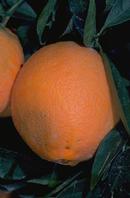
Brown rot
Identification tip: When Phytophthora species
are the cause of infection, the soft dark decay that develops
in citrus occurs mostly on the bottom side of fruit. Fruit
growing near the ground are most likely to develop brown
rot because the fungi infect though spores splashed from
the soil. Brown rot is the most common fruit rot observed
in the orchard.
|

Alternaria rot
Identification tip: Dark brown to black decay is
relatively soft on lemons, but infected tissue is often
relatively firm on navels. This decay develops mostly during
storage but can be identified in the field. If you cut
the fruit in half, you can see the rot
extending into the core. On navels it is also called
black rot.
|
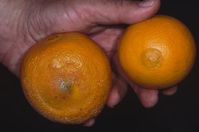
Blue and green mold
Identification tip: A soft watery spot in rinds from infection
by Penicillium species. Easily overlooked when fruit arrives at the packhouse
as shown here, this early infection development stage is also called "clear
rot."
|
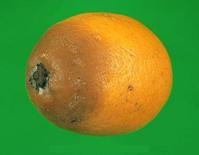
Anthracnose
Identification tip: Brown soft decay of fruit, or discolored
streaks on the rind (called tearstaining) are symptomatic of anthracnose;
the soft decay can develop after infection by Colletotrichum gloeosporioides and
other fungi that cause anthracnose. Anthracnose can be especially severe after
application of insecticidal soap. Septoria spot and occasionally other fungal
diseases cause similar discoloring.
|
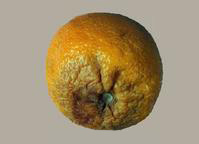
Botrytis rot
Identification tip: Infected fruit can develop
a soft brown decay and may also develop raised brown
or gray bumps, or irregular scars. Botrytis rot develops
during cool, moist conditions, most commonly at coastal
growing areas. Alternaria rot and brown rot cause similar
injury and are more common diseases of citrus than Botrytis
rot.
|
|
| Fungal
mycelia or spore growth—Top
of page |
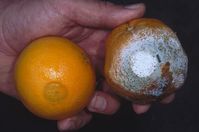
Blue and green mold
Identification tip: White mycelia and blue
or green spores develop on rinds and rinds may wrinkle when
infection by Penicillium spp. becomes more advanced.
|
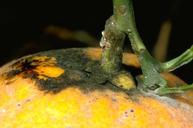
Sooty mold
Identification tip: The dark, felty growth from sooty mold can be
scraped off of plant surfaces, unlike fruit rots that extend into the rind and
flesh. Where sooty mold occurs, look for aphids, citricola scale, cottony cushion
scale, mealybugs, whiteflies, and other phloem-sucking insects that excrete honeydew
on which sooty mold fungi grow.
|
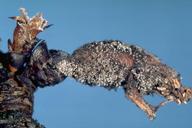
Botrytis rot or gray mold
Identification tip: Pale, fuzzy growth formed by numerous tiny-stalked,
spore-forming structures can develop as velvety mats on dead brown blossoms and
young fruit. In addition to fruit, lemon tree twigs and small branches can become
infected and die.
|
| Firm,
discolored rinds—Top of page |
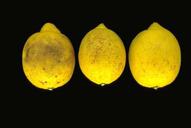
Septoria rot
Identification tip: Septoria produces
dark, pitted botches on infected fruit which are much
more conspicuous after fruit develop their mature color.
Infection usually occurs during wet weather and disease
often does not become apparent until fruit are in storage.
Septoria rot often causes tearstaining (a runny pattern
of discoloring).
|
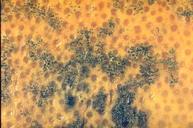
Septoria rot
Identification tip: Infected fruit develop
small, light tan to reddish brown pits in their rind. Bacterial
blast also causes small black spots on rinds; copper fungicide
injury looks very similar, but with phytotoxicity there are
no brown to black Septoria fungal fruiting bodies growing
in the pits (as shown here). Septoria rot pitting is usually
relatively shallow and does not extend deeper than the oil-bearing
tissue.
|
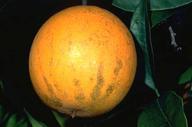
Anthracnose
Identification tip: Brown to reddish green, discolored streaks
on the rind called tearstaining are symptomatic of anthracnose (shown here).
Septoria spot and occasionally other fungal diseases cause similar discoloring.
|
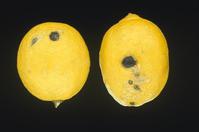
Bacterial blast
Identification tip: Infection results in small black spots
on the fruit. Also called Citrus blast or black pit on
lemons, dead leaves and twigs are often present when
the cause was infection by this bacterium.
|
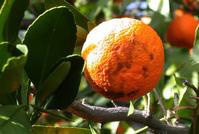
Rind disorder
Identification tip: Brown, water-soaked blotches or dark, sunken
areas develop on the rind after rainy weather and as fruit matures and turns
orange. Secondary fungi may colonize affected areas as the fruit breaks down.
This physiological problem (abiotic disorder) is a problem in California on Satsuma
mandarins.
|
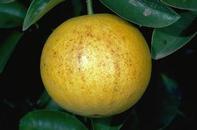
Frost
Identification tip: Brownish stippling most obvious on the outward
facing surface of outer fruit develops after fruit exposure to cold weather.
|

Sunburn
Identification tip: Fruit with yellow to brown
leathery areas occur mostly in the south and west canopy sides
when sunburn is the cause. Sunburned leaves also develop chlorotic
or necrotic spots.
|
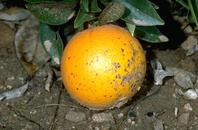
Phytotoxicity
Identification tip: Chemicals, fertilizers, or oils were applied
a few days before this damage appeared. Phytotoxicity can resemble fruit rot
disease. However, pesticide injury often forms a splash pattern, primarily on
the exposed side of fruit. Herbicide (dinoseb) spray caused this necrotic rind
spotting. Certain fungicides (those containing copper) and insecticides (spray
oil) can cause similar injury.
|
|
| Discolored
scabs, scars, or rough wounds on rinds—Top
of page |
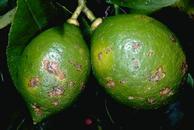
Hail damage
Identification tip: Hail impact causes discolored scars on fruit
and twigs and tears or shreds leaves. Damage occurs on the exposed side of fruit,
including locations not likely to have been impacted by equipment.
|
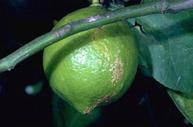
Wind scarring
Identification tip: Shallow, discolored scars on the rind occur when fruit
rub against twigs or thorns, especially on lemon trees at exposed locations.
|
Photograph not available.
Citrus
canker (Bacterial canker)
Identification tip: Raised scabby lesions
develop on fruit, leaves, and twigs. Citrus canker
lesions often have a water-soaked margin and a yellow
halo. Report to agricultural officials this exotic
disease if found in California. |
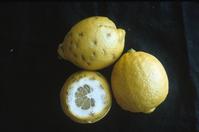
Peteca of lemon
Identification tip: This lemon malady causes depressions
in the rind, which become discolored or brownish.
|
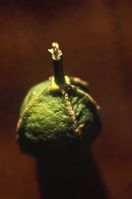
Botrytis rot
Identification tip: Brown raised elongate scars
on this immature lemon were caused by Botrytis infection.
Infected fruit may also develop raised gray bumps or irregular
scars. If fruit are young when infected and conditions remain
wet, fruit may turn brown and die. |
|
| Cracked
rinds or flesh, dry flesh, or flesh separated from the rind—Top
of page |
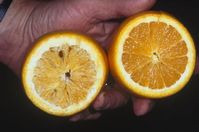
Frost
Identification tip: Dehydrated, dry pulp (left
fruit) after exposure to cold weather in comparison with
the moist, fully expanded flesh in an undamaged orange.
|
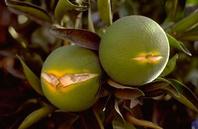
Split fruit
Identification tip: Rinds split at the bottom of fruit after tree
stress, such as extreme weather, inappropriate irrigation, and potassium deficiency.
Decay fungi such as Alternaria rot or blue and green mold often invade wounded
fruit.
|
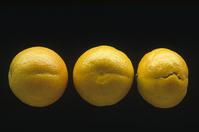
Puff and crease
Identification tip: An uneven appearance
develops on the outer surface of rinds when the outer
rind has separated from inner fruit. The apparent cause
is different growth rates between the inner fruit (endocarp)
and the white layer (albedo) under the peel.
|
| Distorted
or misshapen fruit |
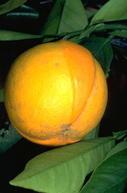
Chimera
Identification tip: A raised section in fruit,
typically in a wedge-shape, is usually from chimera.
This genetic mutation is of minor importance.
|
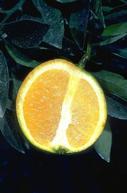
Stubborn disease
Identification tip: Fruit produced by infected
trees are often lopsided and remain undersized. On lemon,
citrus bud mite causes similarly distorted fruit. If distortion
is due to Tristeza, fruit have seed that are smaller and
darker or more pinkish than normal seed.
|
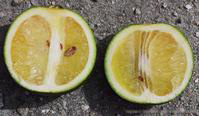
Citrus
greening (Huanglongbing)
Identification tip: Fruit can develop a
lopsided shape if trees are infected with citrus greening.
Stubborn disease, bud mite, chimera, and Tristeza also
can cause misshapen fruit.
|
Photograph not available.
Tristeza
Identification tip: Fruit typically remain smaller than
normal when a tree is infected with Tristeza virus. Leaf
symptoms including yellow foliage and sparse shoot growth
are also often apparent. |
|
|


